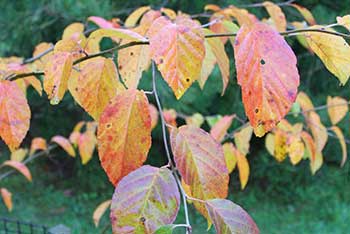An autumn walk with...
So once again I journeyed into the Old Arboretum with the camera to show some more of our autumn goodness here at Westonbirt and there still plenty of it, I can assure you of that!!
I started by heading for one of my favourites, which I am sure many of us have been keeping a close eye on, Acer griseum, the paper bark maple. From China and another Ernest Wilson introduction, it colours slightly later and our oldest specimens (and safe to say among the earliest plantings in this country) are just beginning to colour up nicely.
Our round-headed example at the west end of Mitchell Drive (left photo) is well on the way!
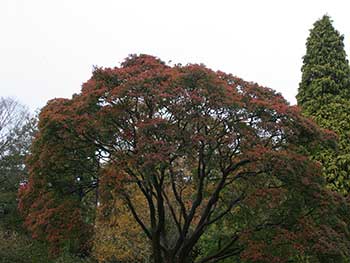
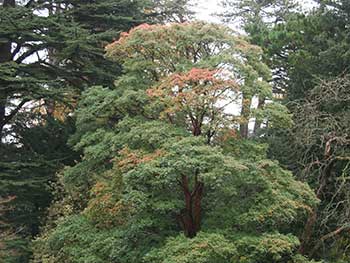
While the taller specimen at close to Lodge Gates (right photo) has plenty still to go. There is also a younger specimen along Mitchell Drive in between these two – another worth visiting! And once the leaves are gone, the bark really takes over as its stand out feature – what a tree!!
Moving on, and set back from Loop Walk close to Morley Ride, the bright red fruits of Sorbus alnifolia are prominent against the dark back drop of the common yew, Taxus baccata.
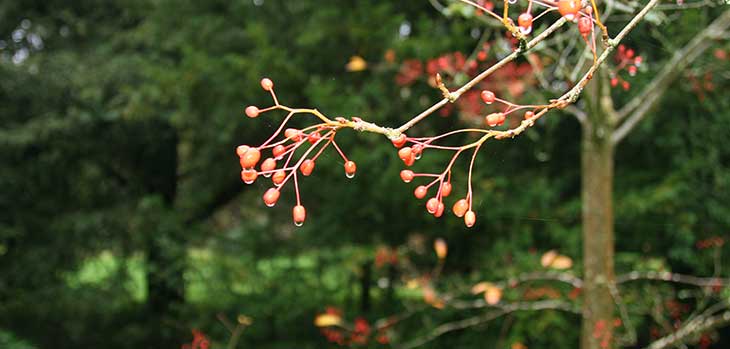
With its foliage long since gone for the year, it is only the fruit of this S. alnifolia remaining to provide seasonal interest. Seek it out before the birds do!!
Further round Loop Walk is a fine example of Acer pennsylvanicum.
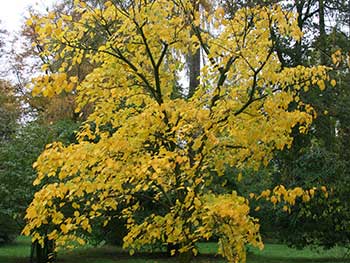
Turning a particularly nice shade of yellow, the leaves were falling as I took this photo (not that you can tell!), so this fine display will not be with us for too much longer for this year. Interestingly, while there are around 20 species of snake bark maple, this is the only one native to North America, the others being Asian representatives this important genus.
Staying with plants of Asian origin is Photinia villosa. Not uncommon, this is known to be a later one to colour in autumn and is certainly doing its thing with us just now! Aside from the fine foliage colour, the fruits are also looking good. Like those of Sorbus alnifolia they are shining a bright red – yet another winner in the Rose family! This individual is growing adjacent to Loop Walk close to the end of Morley Ride, though there are a number of others also looking good just now elsewhere on site, like much else – but don’t take my word for it!!
Back to maples, but only because it’s worth it, we have Acer palmatum subsp. palmatum.
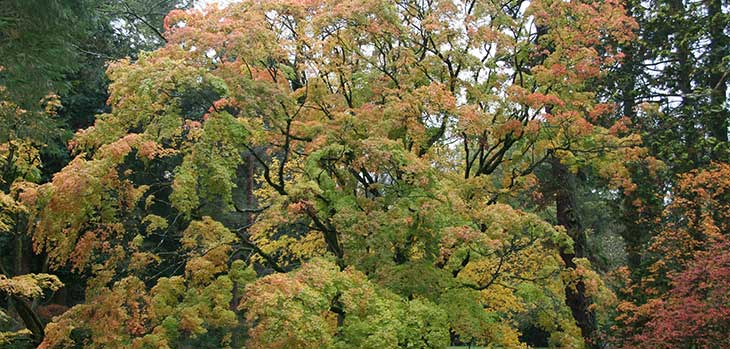
This subspecies is known for its smaller leaves that are held for longer and colour later. True to form, this mature specimen on Pool Avenue is doing just that. Enjoy.
Not far away, in Colour Circle, this example of Taxodium distichum is really coming to the fore right about now.
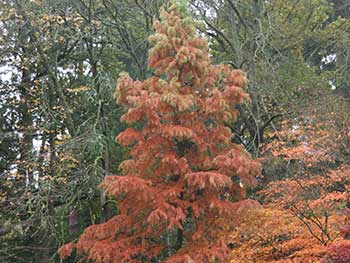
Colouring something of a dark peach, this is another North American favourite. Native to the south eastern states and known as bald, or swamp cypress, it is known for its ‘knees’ when growing in particularly damp areas. Whilst not apparent with us here, its fantastic autumn colour certainly is!
Just across Pool Avenue is this stand of dawn redwood, Metasequoia glyptostroboides.
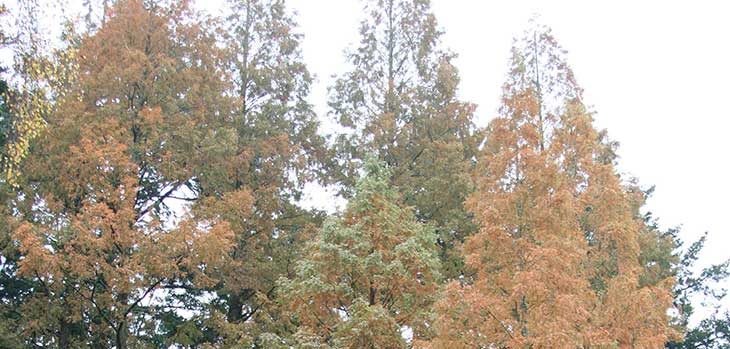
Like the swamp cypress, it is a species of deciduous conifer and both are members of the Cypress family, the Cupressaceae. Endangered in the wild, the dawn redwood was discovered in 1941, having long been thought extinct, and introduced to the U.K in 1949. Our oldest specimen (Growing on Specimen Avenue) was planted in 1953 though this group is younger, with the youngest trees planted in 1991.
Before heading out of the Old Arboretum, I visited a plant I observe on most days heading out into the collection on this side of the valley. Growing close to the bottom of Savill Glade and different from all that has been mentioned in our series of autumn blogs (so far!), Viburnum x bodnantense ‘Dawn’ is one that I am highlighting for its flowers.
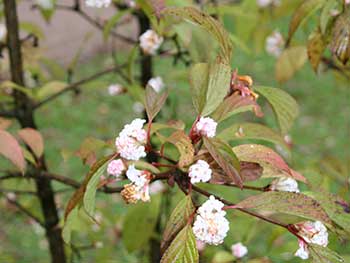
Pale pink and pleasantly scented, these emerge from October onwards and are largely frost-resistant – most welcome as we move out of autumn and into winter. With more than a hint of autumn colour and one of a fantastic genus of (mainly!) shrubs, this is definitely one for the small garden!
Moving into Silk Wood then, and into Sand Earth we have the Japanese Malus tchonoskii.
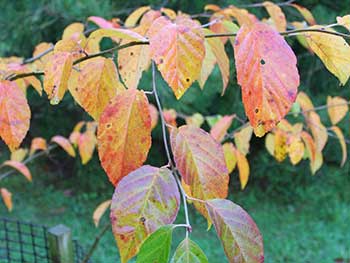
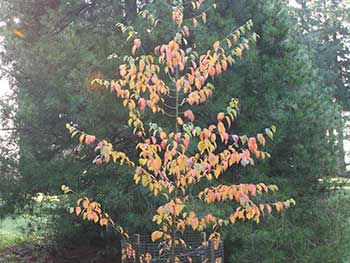
A recent planting with us in 2010, having been collected as seed in the wild by colleagues here at Westonbirt. This example has established well and is now fulfilling its potential as a great autumnal feature. Growing with a lovely conical habit, it looks set to perform a role for us for some time to come – definitely one to keep an eye on!
Back on to Willesley Drive and one that may be easily missed is Hamamelis virginiana.
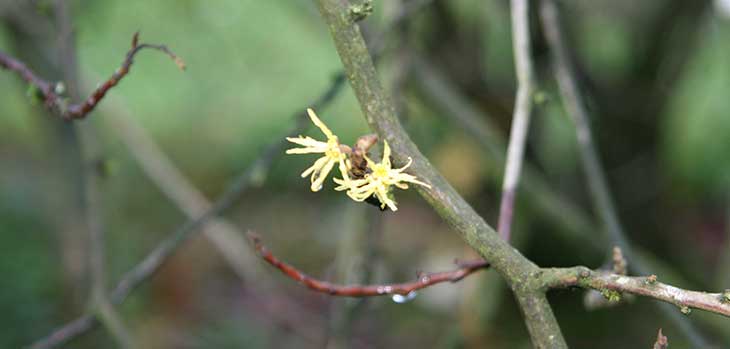
From eastern North America, as the name suggests, it is not notable for its foliage at this time of year, but for its flowers. Flowering earlier than other representatives of the genus, its yellow flowers are also smaller than some, with a pleasant, but subtle scent.
Up to Maple Loop and this area is beginning to really sing! There is all the colour of the Acer palmatum cultivars and the larch (Larix sp.) are also performing admirably.
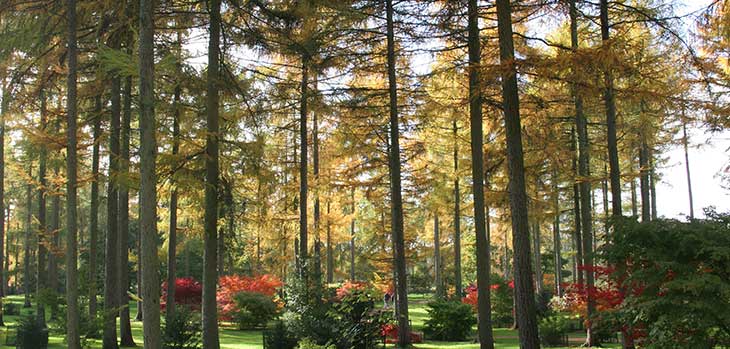
Another genus of deciduous conifer, though this time a member of the Pinaceae, the pine family, larch are clearly more than just plantation trees, though this was their original purpose in this area. This part of the arboretum is becoming a real favourite and is only set to improve as the young plants continue to establish. Swamp cypress also feature here with these young plants, wild collected by our colleagues at Bedgebury Pinetum, looking good to become the overstorey of the future. Like many of our plants we hope they will perform multiple roles in the landscape, providing both structure and autumn colour.
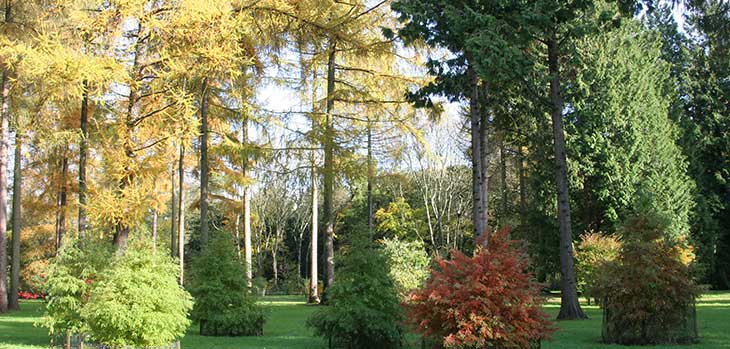
A trip down The Link is always worthwhile and at the Broad Drive end grows a fine young example of Acer pycnanthum.
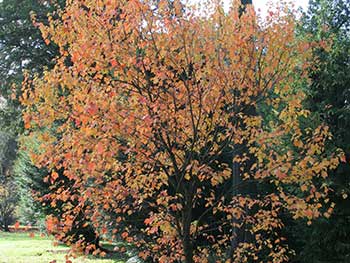
Yet another fantastic plant from Japan. Closely related to the red maple of North America, Acer rubrum, it differs in being both smaller in form and foliage. Whilst our specimens of A. rubrum are among the earliest to colour in autumn, A. pycnanthum tends to be later and is among so many of our trees looking good now. Don’t miss out!
